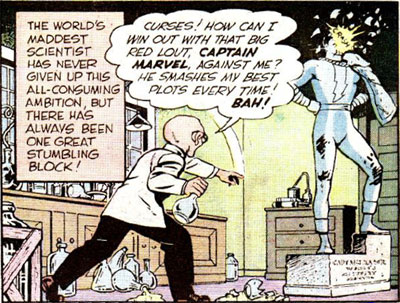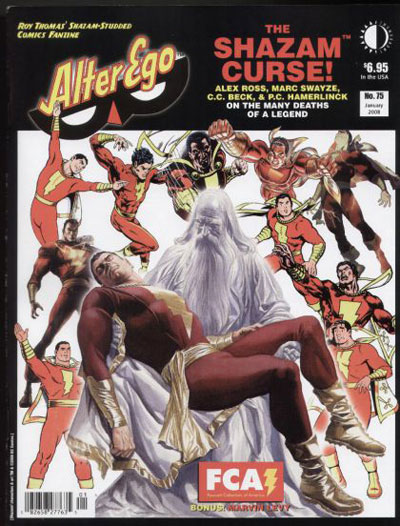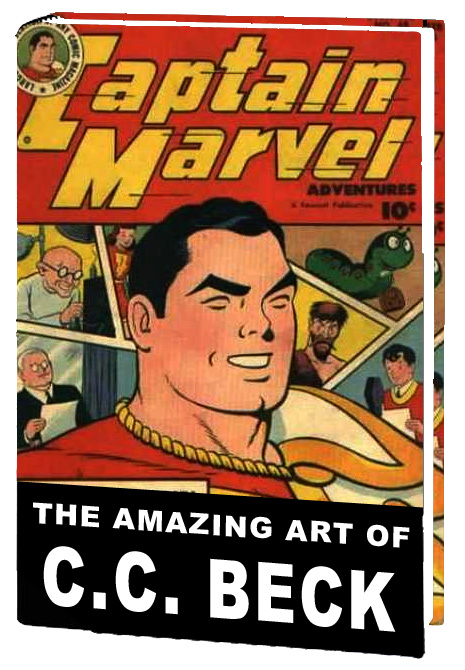 Editors Note:
Editors Note: Normally on Wednesdays, Pierre regales us with stories of growing up reading comics in Canada.
However, I thought it might be interesting to turn the globe a bit and get a
different perspective, so today I'm presenting an article by
Augusto P. Surtida, a comic book reader from the Philippines.
MAKE MINE EC! Memories of a comics aficionado from the Far East by Augusto P. Surtida
Being a former colony of the United States, the Philippines imbibed its politics (liberal democracy), language (English), aspirations, trends, fashion, and pop culture.
Pop culture wa exemplified by Hollywood, sports, recording artists, books, paperbacks, magazines, Sunday funnies, and comic books.
The second world war disrupted all these. But when Douglas McArthur came back in 1945 to keep his promise (“I shall return”) and liberated the Philippines, the good times rolled on.
With the post-war boom, the foreign imports were back with a vengeance. As a baby boomer (born in 1947), I was also a sucker for foreign imports, particularly US print publications including comic books.
As a young child, I was already fascinated by the graphic medium called comics. I could already discern great artworks and drawings, which fueled my choice of comic books to buy and collect.
At first it was the Sunday funnies which were reprinted by local broadsheet newspapers. I always looked forward to weekends because of the comic strips: Tarzan (drawn by John Celardo), Lil Abner, Nancy, Johnny Hazard, Mandrake the Magician, Prince Valiant, The Lone Ranger, The Phantom, Terry and the Pirates, the Spirit, etc., were some of my regular fix during weekends.

The FiftiesAs the fifties progressed, I turned my attention to comic books. There was a wide variety to choose from. Classics Illustrated, EC, DC, Atlas, Harvey, Dell, etc. They were sold in stores, newsstands, and kiosks on street corners that also sold US magazines: Life, Look, Saturday Evening post, Ladies Home Journal, Colliers, Argosy, Saga, National Geographic, etc. Classics Illustrated was the most expensive. They sold for 50 centavos (exchange rate then was 1 US dollar to 2 pesos).
My favorites, though were the EC publications with the titles Vault of Horror, Tales from the Crypt, Frontline Combat, Two-fisted Tales, etc. I wasn’t much on the superhero genre although I read them, too. Superman, Batman, Wonder Woman, Captain Marvel, Captain America, Plastic Man, Shazam, Flash, Green Lantern, Hawkman, The Fly, etc.
My interests were westerns, horror, sci-fi, adventure war stories, and the classics. Samples of these were Lash La Rue, Tom Mix, Rocky Lane, Roy Rogers, Kid Colt Outlaw, Two-Gun Kid, Wyatt Earp, Gunsmoke Western, Billy the Kid, Sheriff of Tombstone, Outlaws of the West, Combat Kelly, and Lorna the Jungle Girl.

And of course there were the TV and movie tie-ins of Dell comics which were: Gunsmoke, Have Gun Will Travel, Lone Ranger, Cheyenne, Range Rider, Tales from Wells Fargo, Wanted: Dead or Alive, Tonto, Rawhide, Maverick, Gene Autry, Rifleman, Bonanza, Wagon Train, Texas John Slaughter, Elfego Vaca, Lawman, Sugarfoot, Jake Pearson and Tales of the Texas Rangers, Sgt. Preston of the Yukon, Jim Bowie, Davy Crockett, Rex Allen, etc.
The other non-western titles from Dell were Tarzan, Turok, Son of Stone, Lassie, Sea Hunt, 77 Sunset Strip, Twilight Zone, Boris Karloff Tales of Mystery, and Jungle Jim. From DC, I bought western titles like Hopalong Cassidy, Tomahawk, and Johnny Thunder. Thunder and Cassidy were illustrated by Gil Kane, one of my favorites then.
War titles from DC which I patronized were Our Army at War (Sgt. Rock), All American Men of War, Our Fighting Forces, G.I. Combat. I also bought the series Sea Devils from DC primarily because it was illustrated by another favorite who was Russ Heath and The Brave and Bold, featuring The Viking Prince, illustrated by Joe Kubert, also another favorite. From Atlas, I bought non-western titles like Tales to Astonish, Uncanny tales, and other similar titles.
I had almost all the titles in Classics Illustrated, including Junior Classics and their other series: The World Around Us. In addition, when EC publications morphed to Mad Comics, I continued to buy.
On to the SixtiesBy this time, Atlas Publications became Marvel, but I didn’t buy those new superheroes by Stan Lee, simply because the artworks didn’t grab me. I resorted to borrowing or renting the new Marvel titles.
At DC, I bought a rare superhero title, Hawkman, because it was drawn by Joe Kubert. I continued to buy their war titles, particularly the new one by Robert Kanigher and Joe Kubert: Enemy Ace, using Manfred von Richtofen a.k.a. The Red Baron as template.
Other Kubert opus which I bought were Firehair, a western, but it didn’t last long. Over at Marvel, I bought Kull the Conqueror also simply it was drawn by John Severin.

By this time, my budget was strained because I was entering college and could not afford the imported titles that I used to like. Besides, some new local titles were worth considering. I am referring to the titles by CRAF Publications. CRAF was born out of the ashes of the defunct Ace Publications, which was closed down due to labor problems. Ace Publications was considered to be the premiere “komiks” publications of the Philippines then. It started in 1947 and ended in 1962. The best local artists and writers were working for Ace then.
CRAF churned out four titles every fortnight: Redondo Komix, Alcala Fight Komix, Fight Klasix, and Amado Lovers Komix. Two masters were incorporators of CRAF, Nestor Redondo and Alfredo Alcala, considered two of the best Filipino illustrators of all time. I collected all the CRAF titles because they featured the best illustrators in the land.
By this time Classics Illustrated had ceased operation, and Gold Key (formerly Dell comics) became rare and almost disappeared. The two competing publications were Marvel and DC because of its superheroes.
By this time also, I reined in my buying of imported comics because of budget difficulties.
The Seventies and BeyondBy the early seventies, I became very selective with my purchases since CRAF Publications folded up in the late sixties. I continued buying DC, however, my choices were extremely few like Enemy Ace, Tarzan of the Apes series by Joe Kubert, and the new western series, Jonah Hex, by John Albano and Tony Zuniga. Even after Zuniga left Jonah, I continued to patronize the Series. I also bought the other DC titles that were featuring works by Filipino artists: House of Mystery, House of Secrets, Swamp Thing, Rima the Jungle Girl, etc.

At Marvel I also did the same thing, that of buying titles which featured Filipino artists such as Conan the Barbarian, and others. My attention, however, was focused now on the magazine format, black and white comics by publisher Jim Warren. I was amazed at the consistent high quality artwork and scripts being spewed by Eerie, Creepy, Vampirella, and 1984. The “Spanish conquest” and “Filipino invasion” of warren magazines added to my interest. My favorite Spanish illustrators toiling for Warren were: Joe Ortiz, Esteban Maroto, Jose Gonzales, Luis Bermejo, and Auraleon. It was like an all-star list.
As if it weren’t enough, American illustrators added to the list like Berni Wrightson, Richard Corben, Frank Thorne, Wallace Wood, Russ Heath, John Severin, and Frank Frazetta. And to up the ante, Filipino masters Alex Nino, Alfredo Alcala, Nestor Redondo, Angel Laxamana, Fred Carillo, Jess Jodloman, etc. were also strutting their stuff. It was too good to be true. And then to provide competition to Warren Publications, Heavy Metal came out. It was the stateside version of the French Metal Hurlant. Moebius, Bilal Serpieri, and others were enough reason to buy the magazine. Both Warren and Heavy Metal were much more expensive than DC, Marvel, and others.
Heavy Metal, if memory serves me right, was sold at P45 – P50 pesos for a brand new copy, in legitimate bookstores and newsstands. They came cheaper if it was a used copy and came from the black market.
Warren magazines were not sold at legitimate outlets. They all came out used from the black market.
I often asked the peddlers at corner kiosks and magazine stands where they got their stuff. They told me they were either from Subic Bay in Olongapo, Zambales where the 7th Fleet of the US Navy was docked, or from Clark Air Base in Pampanga, where the US air force was cooling its heels after air strikes in Vietnam (this was the height of the Vietnam war).
The magazine peddlers got their merchandize from black market operators outside the bases. They collect all stuff thrown out by grunts of the US armed forces and sold them outside the bases. The items wound up in Manila and elsewhere.
Warren magazines sold for P25 – P35 pesos then, and depended on one’s haggling. Other than Heavy Metal, Warren, DC, and Marvel, Playboy, Penthouse, Hustler, National Geographic, etc. were sold too; I even got the Pacific Stars and Stripes for free. It had an excellent comic strip section and sports pages.
But this didn’t last long. After the Vietnam war, Mount Pinatubo eruption, and the termination of the US bases agreement, the supply dried up. Warren magazines ceased existence in the early 80’s. My interest in Heavy Metal also became less when work of Moebius illustrators became few and far between.
During the 80’s, I practically stopped buying comics except for a few notable ones, like adaptation of Lone Wolf and Cub. My interest was on paperbacks by then: Louis L’Amour, Larry McMurtry, Mac Bolan, Death Merchant, and Casca were titles I bought.
By the 90’s, my collection was almost a trickle. I bought the Punisher series, Rivers of Blood because it was illustrated by Joe Kubert.

By the 2000’s I stopped buying entirely. Graphic novels are unaffordable at P500 pesos and above and now I have resorted to borrowing from aficionados.
But sometimes, if I get lucky, there have been a few purchases I remember at bargain bins featuring comic books by Image, Dark Horse, Topps, DC/Vertigo, and Marvel.
Among them were: 300 by Frank Miller, Sin City, also by Miller, Dracula, illustrated by Esteban Maroto, and Indiana Jones, illustrated by Leo Duranona.
Now, looking back, I realize that my generation were basically addicts for American culture during the halcyon days of the 50’s – 60’s which included pop culture and its many manifestations on trends, books, rock and roll, movies, fashion, etc. We were also partakers of the era when the US was at its height politically, economically, and culturally.
Augusto is a true-blue comics aficionado. He is retired and lives in Naga City, Camarines Sur in Southern Luzon, Philippines.



































 Editors Note: Normally on Wednesdays, Pierre regales us with stories of growing up reading comics in Canada.
Editors Note: Normally on Wednesdays, Pierre regales us with stories of growing up reading comics in Canada.
 And of course there were the TV and movie tie-ins of Dell comics which were: Gunsmoke, Have Gun Will Travel, Lone Ranger, Cheyenne, Range Rider, Tales from Wells Fargo, Wanted: Dead or Alive, Tonto, Rawhide, Maverick, Gene Autry, Rifleman, Bonanza, Wagon Train, Texas John Slaughter, Elfego Vaca, Lawman, Sugarfoot, Jake Pearson and Tales of the Texas Rangers, Sgt. Preston of the Yukon, Jim Bowie, Davy Crockett, Rex Allen, etc.
And of course there were the TV and movie tie-ins of Dell comics which were: Gunsmoke, Have Gun Will Travel, Lone Ranger, Cheyenne, Range Rider, Tales from Wells Fargo, Wanted: Dead or Alive, Tonto, Rawhide, Maverick, Gene Autry, Rifleman, Bonanza, Wagon Train, Texas John Slaughter, Elfego Vaca, Lawman, Sugarfoot, Jake Pearson and Tales of the Texas Rangers, Sgt. Preston of the Yukon, Jim Bowie, Davy Crockett, Rex Allen, etc. By this time, my budget was strained because I was entering college and could not afford the imported titles that I used to like. Besides, some new local titles were worth considering. I am referring to the titles by CRAF Publications. CRAF was born out of the ashes of the defunct Ace Publications, which was closed down due to labor problems. Ace Publications was considered to be the premiere “komiks” publications of the Philippines then. It started in 1947 and ended in 1962. The best local artists and writers were working for Ace then.
By this time, my budget was strained because I was entering college and could not afford the imported titles that I used to like. Besides, some new local titles were worth considering. I am referring to the titles by CRAF Publications. CRAF was born out of the ashes of the defunct Ace Publications, which was closed down due to labor problems. Ace Publications was considered to be the premiere “komiks” publications of the Philippines then. It started in 1947 and ended in 1962. The best local artists and writers were working for Ace then. At Marvel I also did the same thing, that of buying titles which featured Filipino artists such as Conan the Barbarian, and others. My attention, however, was focused now on the magazine format, black and white comics by publisher Jim Warren. I was amazed at the consistent high quality artwork and scripts being spewed by Eerie, Creepy, Vampirella, and 1984. The “Spanish conquest” and “Filipino invasion” of warren magazines added to my interest. My favorite Spanish illustrators toiling for Warren were: Joe Ortiz, Esteban Maroto, Jose Gonzales, Luis Bermejo, and Auraleon. It was like an all-star list.
At Marvel I also did the same thing, that of buying titles which featured Filipino artists such as Conan the Barbarian, and others. My attention, however, was focused now on the magazine format, black and white comics by publisher Jim Warren. I was amazed at the consistent high quality artwork and scripts being spewed by Eerie, Creepy, Vampirella, and 1984. The “Spanish conquest” and “Filipino invasion” of warren magazines added to my interest. My favorite Spanish illustrators toiling for Warren were: Joe Ortiz, Esteban Maroto, Jose Gonzales, Luis Bermejo, and Auraleon. It was like an all-star list. By the 2000’s I stopped buying entirely. Graphic novels are unaffordable at P500 pesos and above and now I have resorted to borrowing from aficionados.
By the 2000’s I stopped buying entirely. Graphic novels are unaffordable at P500 pesos and above and now I have resorted to borrowing from aficionados.











